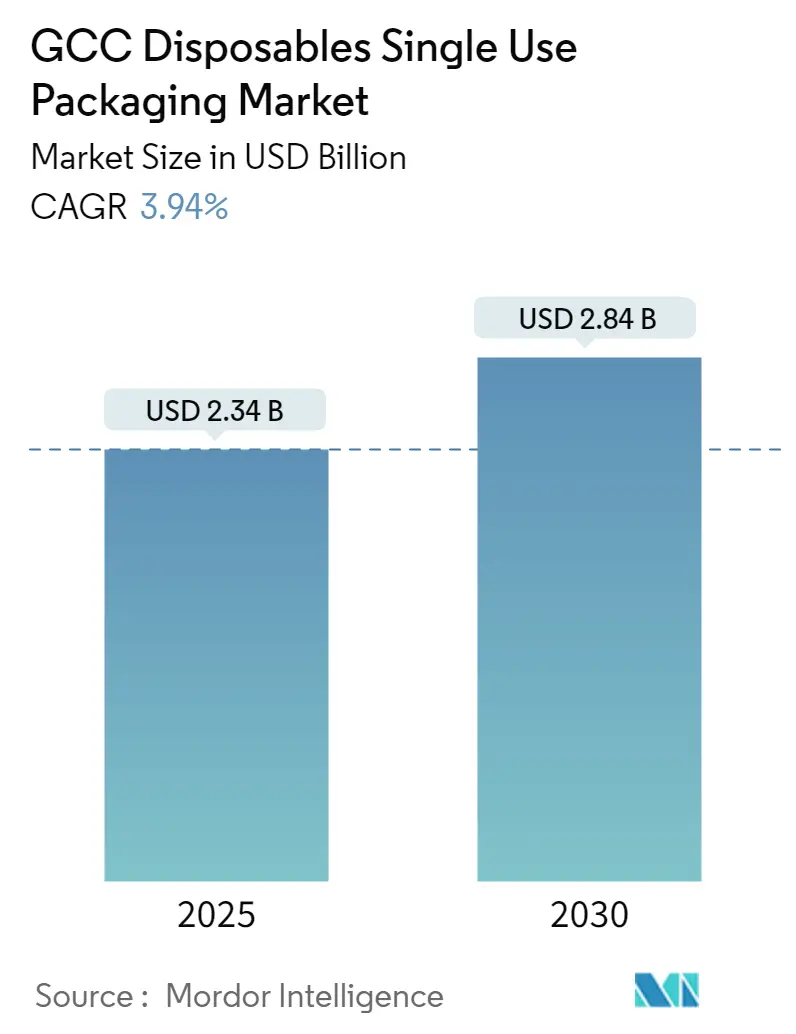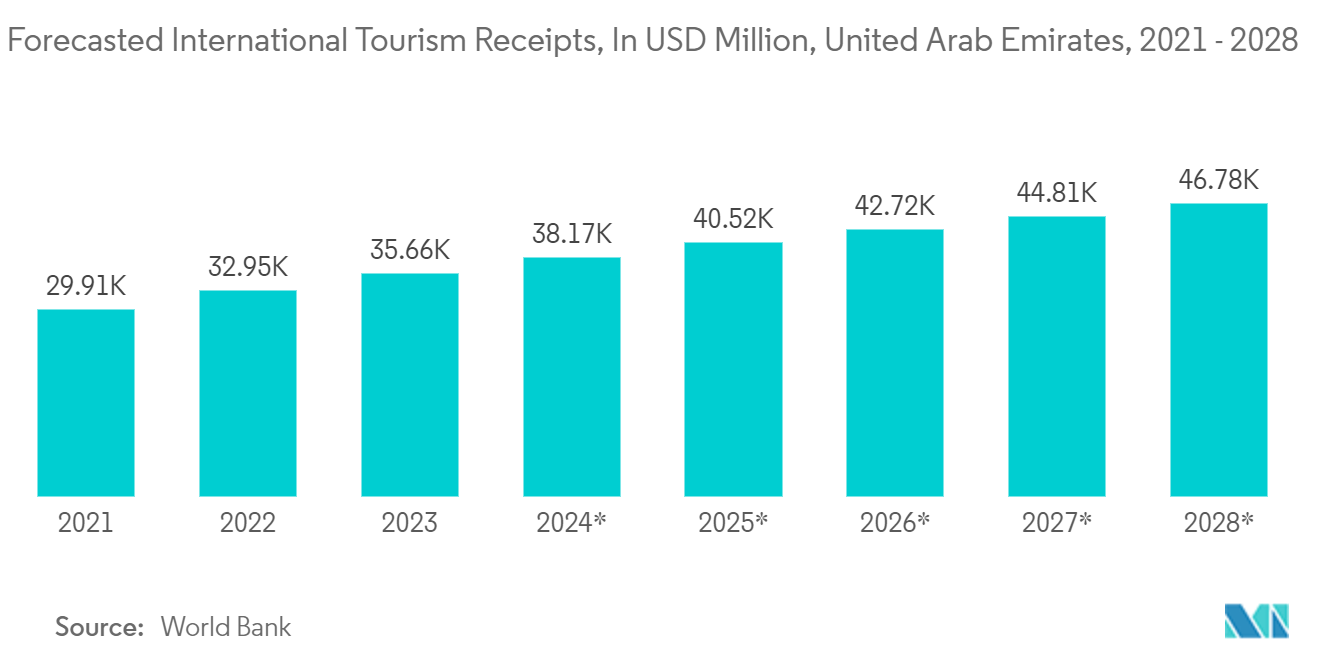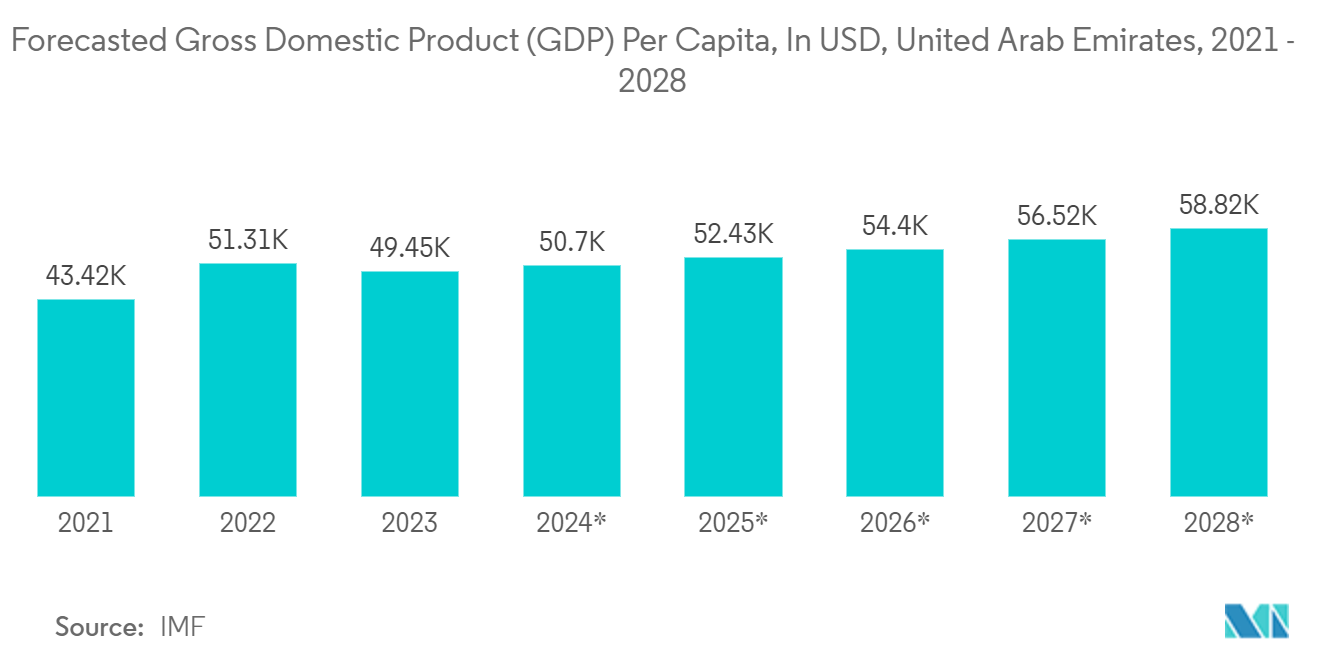GCC Disposables Single Use Packaging Market Analysis
The GCC Disposables Single Use Packaging Market size is worth USD 2.34 Billion in 2025, growing at an 3.94% CAGR and is forecast to hit USD 2.84 Billion by 2030.
Growth in the urban population and the consequent increase in demand for food services significantly impact the market's growth. The amount of money consumers spend on food services has increased dramatically. Packaging is increasingly essential to ensuring food safety and offering convenience to consumers as this trend grows. For example, adequate package labeling enables food preparers to understand the product's source, the appropriate holding temperature, and the necessary amount of cooking.
- The demand for online food delivery services is growing as sustainability and convenience in the food industry become increasingly important. Healthy growth in end-users, such as quick-service restaurants, full-service restaurants, and coffee shops, drives the demand for food-service restaurants. Food delivery service providers are aware of changing customer demands and respond to these changing preferences.
- Increasing smartphone sales and rising internet penetration are driving the growth of the GCC online grocery delivery market. E-commerce continues to transform the GCC's food industry, with consumer confidence remaining relatively high as online grocery shopping and mobile e-commerce offer new ways to purchase groceries and services. In addition, digitization and the emergence of advanced online services are creating growth opportunities for the GCC's online grocery delivery market. For instance, Saudi Arabia has launched the Saudi Vision 2030 program, and the United Arab Emirates is promoting initiatives as part of the UAE Digital Government Strategy 2025.
- Various online food delivery companies are focused on entering the GCC market to expand their regional businesses. For instance, in April 2023, the food delivery app Deliveroo expanded its services across the UAE, Kuwait, and Qatar. The company, which forayed into the GCC market a few years ago by setting up shop in the UAE, will focus on expanding its network of dark kitchens to power its growth.
- Single-use food packaging is taking a significant toll on the environment as it is one of the primary sources of plastic waste. The plastic waste problem in the region is a major environmental issue related to pollution and safe disposal. Despite efforts to use alternative materials and recent developments in biodegradable plastics, the situation still needs improvement. The increasing awareness about the environmental effects of single-use plastic and unsustainable business practices has empowered consumers to demand a higher standard of product with a positive ecological impact. Further, initiatives such as promoting sustainable and biodegradable packaging are expected to negatively impact market growth during the forecast period.
- Presently, the United Arab Emirates, Saudi Arabia, and Egypt drive most of the sector's expansion, accounting for 80% of the total. The whole e-commerce market in the region Before COVID-19, the UAE's digital economy contributed 4.3% to the country's gross domestic product (GDP). Furthermore, according to the Dubai Future Foundation, the country's commerce market is expected to reach USD 62.8 billion by 2023. The industry in Saudi Arabia predicted a market volume of USD 8.2 billion by 2024. In 2023, the GCC's meal delivery market is anticipated to expand further, propelled by rising internet usage and the growing acceptance of online food ordering. The rising use of online delivery, which escalated during the pandemic, would positively impact disposable packaging demand.
GCC Disposables Single Use Packaging Market Trends
Coffee and Snack Outlets to Witness Major Growth
- A strong economy and various communities are projected to support expansion in the GCC cafe and snack outlets in the next years. In the UAE, the food market is booming, especially in the café and bakery sectors. Even when the financial crisis hit in 2008, the cafe sector saw little difficulties as it emerged from the challenging stage.
- A sizable portion of the coffee and snack shop clients are adolescents. In a paper emphasizing the demographic transition in the GCC, Kuwait Financial Centre (Markaz) stated that the area is young, with 54% of residents under the age of 25. However, this is anticipated to climb to 36 years by 2050. Brands are trying to innovate their product range to attract young customers. Such trends are driving the growth of the cafes and bakery industry in GCC.
- In addition, to increase tourist numbers and reduce their reliance on an oil-based economy, the continent is currently seeing massive investments in the hospitality and tourism sectors. Due to increased commercial developments and an influx of visitors from abroad who want to try new local coffee beverages, the market is anticipated to grow substantially in the upcoming years.
- As per the data from the World Bank, between 2024 and 2028, the United Arab Emirates' foreign tourism receipts were expected to increase by a cumulative USD 11.1 billion (+31.17%). According to estimates, tourism receipts will hit a new peak in 2028 when they reach USD 46.8 billion, marking the eighth consecutive year of increasing tickets. With the growth of tourist footfall in the region, there would be a recovery in demand for disposable cups for refreshers in Cafes and snacks outlets across the region.
- Coffee obsession and consumption have gone through the roof in the United Arab Emirates. However, tea is the most popular drink in the United Arab Emirates. Such factors drive the market for disposable paper cups in cafeterias across the region.
United Arab Emirates to Register Significant Growth
- The growing popularity of disposable packaging in the United Arab Emirates may boost the market. The reasons behind the shift in attention to disposable packaging products such as trays, boxes, cartons, plates, bottles, and cups are sustainability, hygiene factors, ease of disposal, and growing consumer awareness of on-the-go consumption in the United Arab Emirates.
- Moreover, the standard of living in the United Arab Emirates is one of the highest in the world. A liberal, business-friendly, market-oriented growth strategy has transformed the economy. The non-oil sector expanded steadily as the economy diversified. However, due to its increasing diversification, the UAE has been hit harder by the global financial crisis than its neighbors. Abu Dhabi and Dubai account for about 80% of the UAE's income.
- With the growth of end-user industries, primarily food and other non-food sectors, the demand for disposable packaging products such as boxes and folding cartons is expected to grow over the forecast period. UAE has a much more diverse population who are health conscious and prioritize health-based food products, including food, processed breakfast cereals, wholegrain cereals, and an equal proportion of fruits and vegetables consumed as a salad. According to the managing director of Hotpack Global, the food packaging industry in the UAE is expected to grow to AED 14 billion (USD 3.81 billion) by 2025. More international food brands in the MENA markets have also contributed significantly to the sector's growth.
- In countries like the United Arab Emirates, Qatar, and Saudi Arabia eating in restaurants is now widely recognized as the place to celebrate special occasions and have fun with the family. According to International Monetary Fund (IMF), the United Arab Emirates' gross domestic product is predicted to grow steadily between 2023 and 2028 by USD 9,365 (+18.94%). In 2028, the GDP per person is anticipated to reach USD 58,816.62.
- Furthermore, the United Arab Emirates is witnessing a significant demand for pharmaceutical products. The United Arab Emirates imports pharmaceutical products from 72 countries. IQVIA projected that pharmaceutical sales in the country might reach USD 51 billion by 2024. Moreover, increased awareness about the established benefits of secondary packaging for pharmaceutical products and healthcare facilities drives the market.
GCC Disposables Single Use Packaging Market Overview
The GCC Disposables (Single-Use) Packaging Market is fragmented with many players in the industry, such as Huhtamaki Oyj, Falcon Pack, Hotpack Packaging LLC, and more. Additionally, the region has seen the introduction of various multinational fast-food chains, offering a wide variety of food services, leaving consumers with ample options. In addition to the top GCC economies, nations like Qatar, Kuwait, and Bahrain offer a promising area for investment in the food service industry.
In May 2023, the manufacturer of disposable packaging products based in the UAE, Hotpack, signed a contract with Maxbyte, a provider of industrial digital, robotics, and training solutions, to digitally transform all 15 of its plants there and in other nations. Three of Hotpack's plants in Umm Al Quwain, National Industries Park, and Dubai Investments Park 2 will undergo the first phase of the company's Industry 4.0 transformation roadmap. At the end of the three to five-year term, the transformation roadmap's ultimate objective is to have reached the highest degree of Industry 4.0 maturity. Hotpack eventually wants to digitize all 15 manufacturing facilities to become a smart, connected, and sustainable business.
In April 2023, Hotpack Global announced intentions to develop one of the world's largest sustainable packaging plants in Saudi Arabia. With a projected expenditure of SAR1 billion (USD 0.26 million), the facility will be constructed over seven years on a 2.4 million square foot of land.
GCC Disposables Single Use Packaging Market Leaders
-
Jebel Pack LLC
-
Detpak - Detmold Group
-
Falcon Pack
-
Precision Plastic Products Co. (LLC)
-
Freshpack LLC
- *Disclaimer: Major Players sorted in no particular order
GCC Disposables Single Use Packaging Market News
- January 2023 : KEZAD Group, the trade, logistics, and industrial hub of Abu Dhabi, announced the signing of a 50-year land lease agreement with specialty tissue manufacturer Star Paper Mill for the establishment of a new facility to manufacture recycled Kraft Paper Jumbo reels, diversifying the company's product offering to serve a growing demand for biodegradable packaging papers in the UAE.
- November 2022 : HotpackGlobal, a significant disposable packaging company, opened a manufacturing facility in Qatar. The cutting-edge manufacturing facility is a specialized factory that will create a wide range of Hotpack'spaper products, including folding and corrugated cartons, paper bags, and cups. It is situated in Doha's new industrial region.
GCC Disposables Single Use Packaging Market Industry Segmentation
The study tracks the demand for disposable packaging options in terms of sales offered by various vendors operating in the GCC region. The impact of COVID-19 has also been considered for current market estimation and future growth projections. The study on GCC disposable packaging Market tracks demands for Trays, Plates, Food Containers, and Bowls, Boxes and Carton, Bottles, Cups and Lids on the high level while it tracks the market size in terms of revenue for the respective end-user industry verticals in the respective countries from the listed product types.
The GCC disposables (single-use) packaging market is segmented by product type (trays, plates, food containers, & bowls, boxes & cartons, bottles, cups & lids, clamshells, bags & wraps), end-user applications (quick service restaurants, full-service restaurants, coffee and snack outlets, retail establishments, institutional and hospitality), and by Country (United Arab Emirates, Saudi Arabia, Rest of GCC). The report offers market forecasts and size in value (USD) for all the above segments.
| By Product Type | Trays, Plates, Food Containers, and Bowls |
| Boxes and Cartons | |
| Bottles | |
| Cups and Lids | |
| Clamshell | |
| Bags and Wraps | |
| Other Product Types (Cutlery, Stirrers/Straws, etc.) | |
| By End-user Application | Quick Service Restaurants |
| Full-service Restaurants | |
| Coffee and Snack Outlets | |
| Retail Establishments | |
| Institutional and Hospitality | |
| Other End-user Applications | |
| By Country | United Arab Emirates |
| Saudi Arabia |
GCC Disposables Single Use Packaging Market Research FAQs
How big is the GCC Disposables (Single-Use) Packaging Market?
The GCC Disposables (Single-Use) Packaging Market size is worth USD 2.34 billion in 2025, growing at an 3.94% CAGR and is forecast to hit USD 2.84 billion by 2030.
What is the current GCC Disposables (Single-Use) Packaging Market size?
In 2025, the GCC Disposables (Single-Use) Packaging Market size is expected to reach USD 2.34 billion.
Who are the key players in GCC Disposables (Single-Use) Packaging Market?
Jebel Pack LLC, Detpak - Detmold Group, Falcon Pack, Precision Plastic Products Co. (LLC) and Freshpack LLC are the major companies operating in the GCC Disposables (Single-Use) Packaging Market.
What years does this GCC Disposables (Single-Use) Packaging Market cover, and what was the market size in 2024?
In 2024, the GCC Disposables (Single-Use) Packaging Market size was estimated at USD 2.25 billion. The report covers the GCC Disposables (Single-Use) Packaging Market historical market size for years: 2019, 2020, 2021, 2022, 2023 and 2024. The report also forecasts the GCC Disposables (Single-Use) Packaging Market size for years: 2025, 2026, 2027, 2028, 2029 and 2030.
Our Best Selling Reports
GCC Disposables Single Use Packaging Market Industry Report
Statistics for the 2025 GCC Disposables Single Use Packaging market share, size and revenue growth rate, created by Mordor Intelligence™ Industry Reports. GCC Disposables Single Use Packaging analysis includes a market forecast outlook for 2025 to 2030 and historical overview. Get a sample of this industry analysis as a free report PDF download.

_Packaging_Market_Major_Players_Logo.webp)



_Packaging_Market_Concentration.webp)

